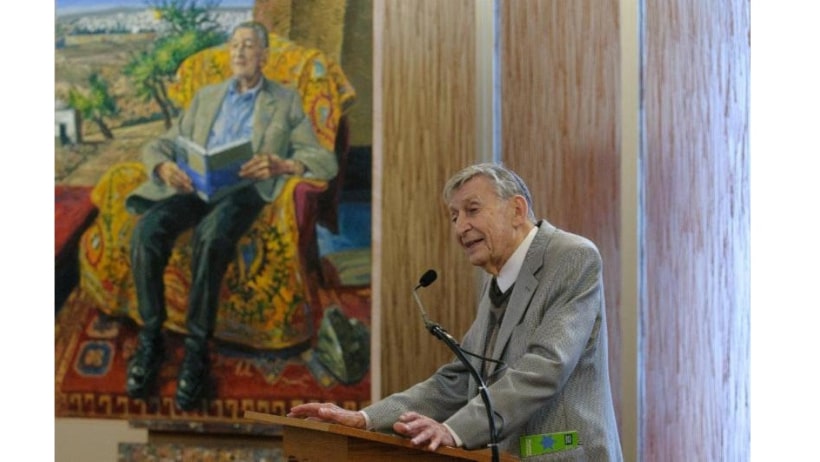Oasis Songs: Musings from Rav D
Friday, January 3, 2020 / 6 Tevet 5780
Summary: As we all mourn the loss of Rabbi Stampfer, z”l, it seems appropriate for our community as a whole to observe sheloshim, a set of mourning practices. Rabbi Stampfer’s sheloshim ends on Monday, January 27th, Rosh Chodesh Shevat.
Observing this will provide us with an individual and communal framework to move through our grief and to honor our leader. In this week’s Oasis Songs, we will learn the history of sheloshim, why we need to mourn him in this way and discuss what this special mourning entails.
During times of difficult loss, we are blessed to have a tradition that provides us with guidance on navigating the powerful emotions we each may be experiencing. Please reach out to your clergy during this time. We are all here for you.
As an addendum, thank you to all who attended Rabbi Stampfer’s funeral or came for the shivah minyanim. It was a tremendous support to the family, to me and a magnificent statement of who we are as a community.
Finally, my apologies. I had intended to get this out to the community sooner. As you can imagine, however, it has been quite the week.
Thirty Days: A History
When Moshe Rabbeinu died, the Israelites mourned thirty days for Moses. (Deuteronomy 34:8). When Aaron died, our ancestors also mourned for thirty days (Numbers 20:29). These are the sources for our tradition’s custom of sheloshim. What is interesting is how these very public observances of sheloshim changed and became reserved for our closest of kin.

There are both practical and more elevated reasons for that modification and restriction. Certainly, people need to make a living and are otherwise busy with their lives. It would be a tircha, a hardship, if we communally had to observe sheloshim for any relative or any leader who passed away. One of the beauties of our heritage is that even as we are inspired by the highest ideals, we are simultaneously grounded in the tachlis, in basic requirements. Jews don’t beat around the bush. We like it straight.
Additionally, on the spiritual level, it seems clear that our Sages wanted to draw a distinction between two of our greatest leaders and everyone else. An example of this concept is found in a famous saying about Rambam (Moses Ben Maimon), who was one of the greatest and most influential Jewish thinkers of all time. The phrase is: miMoshe ad Moshe lo kam k’Moshe— “from Moses to Moses, no one arose like Moses.”
A tachlis people isn’t going to make false comparisons or allow themselves the pleasure of overwrought praise. Praise means most when it isn’t given too readily, as common sense and modern psychology have shown.
Nonetheless, there are examples in which Judaism returns us to this ancient Biblical precedent of mourning. In our legal codes, a discussion is had about who one is obligated to honor. In certain cases, one’s rav muvhak, one’s primary teacher of Torah, steps into a halakhic space normally reserved for a parent. We honor that person and care for them as if they were our parent.
So too, there is a tradition that for a G’dol Dor, one of the greatest leaders of a generation, we observe sheloshim.
Why Rabbi Stampfer Should be Considered One of the Greats
Was Rabbi Stampfer a “g’dol dor?” I want to imagine that he would have scoffed at anyone trying to apply that title to him. At the very least, he would want to make sure people knew the history of the phrase. In more recent times, this title has been reserved for those who had the greatest attainments in Jewish learning—book learning. Rabbi Stampfer was a lamdan, a learned Jew. But it would be going too far to claim his knowledge was of that level.
In the Talmud and earlier days, however, a g’dol dor did not refer solely to Jewish learning, but to general leadership and influence. In this regard, it would almost be heretical not to apply the title to Rabbi Stampfer. As much as any person, he built Jewish Portland. He transformed it through his institution-building elan. He was our great one.
Given that, it seems like we would be amiss if we did not observe sheloshim for him.
Thirty Days: A Practical Guide
So what are some of the observances associated with sheloshim?
- We wouldn’t cut our hair or shave.
- In earlier times when laundry wasn’t regularly done, people would refrain from cleaning their clothes.
- People wouldn’t attend parties.
- Kaddish would be recited.
For each of these obligations, there are exceptions. As an example, if you decide not to cut your hair or shave and it jeopardizes your job or people start complaining to you about your appearance, you are permitted to groom yourself.
Additionally, some people feel comfortable reciting Kaddish d’Rabbanan but not the Mourner’s Kaddish for a non-relative.
We are in a period of communal mourning. We are all invited to recite kaddish at services for Rabbi Stampfer. Simultaneously, we each need to make personal decisions as to what we will observe for ourselves. What I hope is that each of us will do something to mark this time as different, to set it aside for grieving and to understand that something has changed in our world. Nothing looks quite the same.
Yetziat Tzadik Oseh Roshem.
When a Tzadik departs, their absence is felt.
Blessings,
Rav D
Shabbat Table Talk
- Which of Rabbi Stampfer’s institutions have you benefited from?
- How will you mourn and mark his loss?
If you’d like to continue this discussion, follow this link to CNS’s Facebook page to share your own perspectives on the topics raised in this week’s Oasis Songs. Comments will be moderated as necessary.



